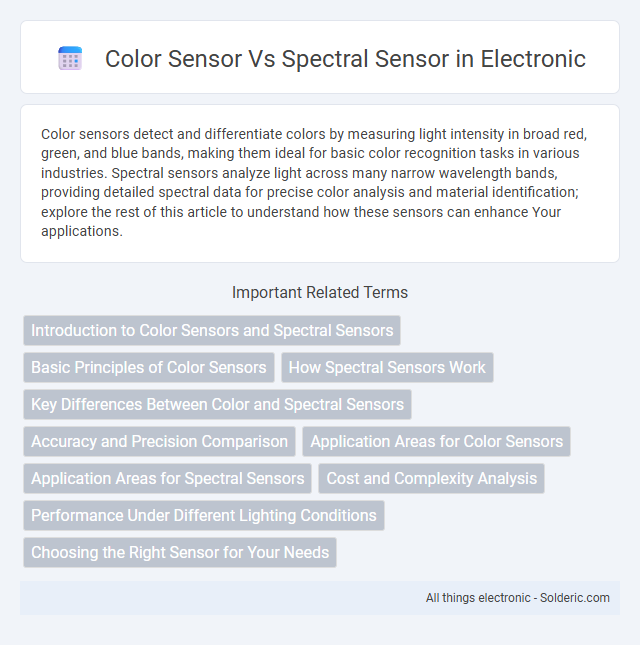Color sensors detect and differentiate colors by measuring light intensity in broad red, green, and blue bands, making them ideal for basic color recognition tasks in various industries. Spectral sensors analyze light across many narrow wavelength bands, providing detailed spectral data for precise color analysis and material identification; explore the rest of this article to understand how these sensors can enhance Your applications.
Comparison Table
| Feature | Color Sensor | Spectral Sensor |
|---|---|---|
| Function | Detects basic color values (RGB, CMY) | Measures detailed light spectrum across multiple wavelengths |
| Spectrum Range | Limited to visible light and basic color bands | Broad spectrum, including visible, UV, and IR ranges |
| Accuracy | Moderate color identification | High spectral resolution and precision |
| Applications | Color sorting, display calibration, basic color detection | Material analysis, quality control, spectral imaging |
| Cost | Lower cost, simpler design | Higher cost, complex design |
| Output Data | Discrete color values (e.g., RGB) | Continuous spectral data across wavelengths |
Introduction to Color Sensors and Spectral Sensors
Color sensors detect and measure specific color components by using RGB filters or photodiodes, providing quick and cost-effective color identification in applications like consumer electronics and industrial automation. Spectral sensors analyze the full spectrum of light wavelengths, delivering detailed spectral data for precise material characterization, quality control, and scientific research. The choice between color sensors and spectral sensors depends on the required accuracy, complexity, and application needs, with spectral sensors offering higher resolution and color sensors offering simplicity and speed.
Basic Principles of Color Sensors
Color sensors detect and measure light intensity in specific wavelength bands, typically red, green, and blue, to determine the color of an object based on reflected light. These sensors use photodiodes or phototransistors with color filters to capture approximate color information quickly and cost-effectively. Unlike spectral sensors, which analyze a broad spectrum in high resolution, color sensors provide lower spectral accuracy but are ideal for applications requiring fast, simple color detection.
How Spectral Sensors Work
Spectral sensors analyze the intensity of light across a wide range of wavelengths, providing detailed spectral data that allows precise identification of materials and colors beyond just basic color matching. Unlike traditional color sensors that detect only red, green, and blue components, spectral sensors measure hundreds of narrow spectral bands, enabling accurate detection of subtle differences in color and chemical composition. Your applications benefit from enhanced accuracy and versatility in quality control, agriculture, and environmental monitoring where detailed spectral information is crucial.
Key Differences Between Color and Spectral Sensors
Color sensors detect and measure specific colors based on predefined color filters, providing simple RGB or CMY data useful for applications like display calibration and basic color recognition. Spectral sensors capture a continuous spectrum across numerous narrow wavelength bands, delivering detailed spectral fingerprints that enable precise material identification, quality control, and advanced color analysis. Key differences include spectral resolution, data richness, and application scope, with spectral sensors offering higher accuracy and versatility compared to the limited, discrete data from color sensors.
Accuracy and Precision Comparison
Color sensors provide basic color detection with moderate accuracy, ideal for applications requiring fast, simple color identification. Spectral sensors offer high precision by capturing detailed spectral data across multiple wavelengths, enabling more accurate color measurement and differentiation. Your choice impacts results significantly: spectral sensors excel in applications demanding exact color matching, while color sensors suit less critical uses.
Application Areas for Color Sensors
Color sensors are commonly used in applications such as quality control in manufacturing, product sorting, and display calibration, providing fast and accurate color detection. These sensors excel in detecting specific colors or color differences in industries like food processing, textiles, and packaging. Your choice of a color sensor depends on the precision required, as they are optimized for scenarios where identifying distinct colors quickly is essential.
Application Areas for Spectral Sensors
Spectral sensors are extensively used in precision agriculture to monitor crop health by analyzing light absorption and reflectance for nutrient and moisture levels. These sensors enable environmental monitoring through detailed spectral data to assess water quality, air pollution, and ecosystem changes. In industrial applications, spectral sensors optimize quality control by identifying material composition and detecting contaminants with high accuracy.
Cost and Complexity Analysis
Color sensors offer a cost-effective solution for basic color detection by measuring red, green, and blue light intensities, making them ideal for simple applications with limited budgets. Spectral sensors provide detailed wavelength analysis across a broader spectrum, resulting in higher hardware complexity and increased costs due to advanced components and data processing requirements. Your choice depends on balancing budget constraints with the need for precision and spectral resolution in your application.
Performance Under Different Lighting Conditions
Color sensors provide accurate color detection in controlled lighting but often struggle with inconsistent or low-light environments, leading to reduced reliability. Spectral sensors, capturing detailed wavelength information across the spectrum, maintain superior performance under varying lighting conditions, improving precision and adaptability. You can achieve more consistent and dependable color measurement with spectral sensors in dynamic or challenging lighting scenarios.
Choosing the Right Sensor for Your Needs
Choosing the right sensor depends on your specific application requirements; color sensors detect RGB values for simple color identification, making them ideal for cost-sensitive projects or basic quality control. Spectral sensors capture detailed wavelength data across a broader spectrum, enabling precise color measurement and material analysis essential for advanced research or industrial processes. Your selection should balance accuracy needs, budget, and complexity to ensure optimal sensor performance.
color sensor vs spectral sensor Infographic

 solderic.com
solderic.com